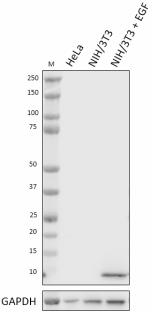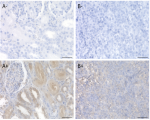- Clone
- Poly5235 (See other available formats)
- Regulatory Status
- RUO
- Other Names
- Urogastrone (URG), HOMG4
- Isotype
- Goat Polyclonal IgG
- Ave. Rating
- Submit a Review
- Product Citations
- publications

-

Recombinant human EGF (Cat. No. 585506) (black circles) inhibits proliferation on human epithelial A431 cells. LEAF™ purified anti-human EGF antibody (Poly5235) (purple squares) neutralizes the cell proliferation inhibited by recombinant human EGF at 4 ng/mL in human epithelial A431 cells in a dose-dependent manner, whereas the LEAF™ purified goat IgG, isotype ctrl antibody (gray triangles) does not have the effect. ND50 range: 0.1 - 0.5 μg/mL. -

Whole cell extracts (15 µg total protein) from HeLa, and NIH/3T3 cells spiked with or without the indicated amount of Recombinant human EGF protein (Cat. No. 585506) were resolved by 4-12% Bis-Tris gel electrophoresis, transferred to a PVDF membrane, and probed with 0.5 µg/mL purified anti-human EGF (clone Poly5235) overnight at 4°C. Proteins were visualized by chemiluminescence detection using HRP donkey anti-goat. Direct-Blot™ HRP anti-GAPDH (Cat. No. 607904) was used as a loading control at a 1:50,000 dilution (lower). Lane M: Molecular weight marker -

IHC staining of anti-human EGF (clone Poly5235) on formalin-fixed paraffin-embedded human kidney (A) and human spleen (B). Following antigen retrieval using Sodium Citrate H.I.E.R. (Cat. No. 928502), the tissue was incubated with (+) or without (-) 10.0 μg/mL of the primary antibody overnight at 4°C. BioLegend’s Ultra Streptavidin HRP Kit (Multi-Species, DAB, Cat. No. 929501) was used for detection followed by hematoxylin counterstaining, according to the protocol provided. The image was captured with a 40X objective. Scale bar: 50 μm
| Cat # | Size | Price | Quantity Check Availability | Save | ||
|---|---|---|---|---|---|---|
| 523503 | 100 µg | 352€ | ||||
Epidermal growth factor (EGF) is a small 6 kD polypeptide and has six conserved cysteine residues that form three intramolecular disulfide bonds. Human and mouse EGF share 70% homology in amino acid structure. Human EGF is synthesized as a transmembrane precursor protein (1207 amino acids) which is proteolytically cleaved to generate the 54 amino acid mature EGF. Many different cells including mammary gland cells, macrophages, gut epithelial cells, and cells in the nervous system and the kidney can produce EGF. EGF plays important roles in the regulation of cell survival, proliferation, and differentiation by binding to its receptor EGFR. For example, EGF can stimulate the proliferation of mouse embryonic stem cells or induce the terminal differentiation/growth inhibition of A431 cells. The binding of EGF to EGFR will induce receptor dimerization, which is required for activating the tyrosine kinase in the receptor cytoplasmic domain. In addition, the binding of EGF to its receptor triggers several signal transduction pathways including JAK/STAT, Ras/ERK, and PI3K/AKT pathways. Blocking of the EGF/EGFR pathway can suppress some tumor cell's proliferation. Other members of the EGF family (including transforming growth factor-α (TGF-α), heparin-binding EGF-like growth factor (HB-EGF), amphiregulin (AR), betacellulin (BTC), epiregulin (EPR), and epigen also bind to EGFR.
Product DetailsProduct Details
- Verified Reactivity
- Human
- Antibody Type
- Polyclonal
- Host Species
- Goat
- Immunogen
- Recombinant human EGF
- Formulation
- 0.2 µm filtered in phosphate-buffered solution, pH 7.2, containing no preservative.
- Endotoxin Level
- Less than 0.1 EU/µg of the protein (< 0.01 ng/µg of the protein) as determined by the LAL test.
- Preparation
- The LEAF™ (Low Endotoxin, Azide-Free) antibody was purified by affinity chromatography.
- Concentration
- Lot-specific (to obtain lot-specific concentration and expiration, please enter the lot number in our Certificate of Analysis online tool.)
- Storage & Handling
- Upon receipt, store frozen at -20°C. Make small volume aliquots if needed and avoid repeated freeze-thaw cycles to prevent denaturing the antibody.
- Application
-
Neut - Quality tested
WB, IHC-P - Verified - Recommended Usage
-
Each lot of this antibody is quality control tested by neutralizing the inhibited proliferation induced by recombinant human EGF (Cat. No. 585506) at 4 ng/mL on human epithelial A431 cells. ND50 range: 0.1 - 0.5 µg/mL. For western blotting, the suggested use of this reagent is 0.125 - 1.0 µg/mL. For immunohistochemistry on formalin-fixed paraffin-embedded tissue sections, a concentration range of 5.0 - 10.0 µg/mL is suggested. It is recommended that the reagent be titrated for optimal performance for each application.
- RRID
-
AB_2904433 (BioLegend Cat. No. 523503)
Antigen Details
- Structure
- Growth factor
- Distribution
-
Mammary gland cell, macrophage, gut epithelial cells, cells in the nervous system, kidney
- Function
- EGF is a potent mitogen for many cells in culture, and in vivo, it induces the proliferation and differentiation of skin, cornea, lung, and trachea, among other tissues. Processing of pro EGF to mature EGF in different tissues is not equally efficient. The precursor is processed to mature EGF in the submaxillary gland, pancreas, small intestine, and mammary gland. In the submaxillary gland, EGF is fully processed, stored at secretory granules, and secreted in saliva. In kidney, EGF is present in unprocessed or intermediated forms on the cell surface.
- Interaction
- Epithelial cells, epidermal cells, and fibroblasts
- Ligand/Receptor
- EGFR
- Antigen References
-
- Henson ES and Gibson SB. 2006. Cell Signal. 18:2089.
- Burgess AW, et al. 2003. Mol. Cell. 12:541.
- Imai Y, et al. 1982. Cancer Res. 42:4394.
- Barnes DW. 1982. J. Cell. Biol. 93:1.
- Heo JS, et al. 2006. Am. J. Physiol. Cell. Physiol. 290:C123.
- Gene ID
- 1950 View all products for this Gene ID
- UniProt
- View information about EGF on UniProt.org
Related Pages & Pathways
Pages
Related FAQs
- Do you guarantee that your antibodies are totally pathogen free?
-
BioLegend does not test for pathogens in-house aside from the GoInVivo™ product line. However, upon request, this can be tested on a custom basis with an outside, independent laboratory.
- Does BioLegend test each Ultra-LEAF™ antibody by functional assay?
-
No, BioLegend does not test Ultra-LEAF™ antibodies by functional assays unless otherwise indicated. Due to the possible complexities and variations of uses of biofunctional antibodies in different assays and because of the large product portfolio, BioLegend does not currently perform functional assays as a routine QC for the antibodies. However, we do provide references in which the antibodies were used for functional assays and we do perform QC to verify the specificity and quality of the antibody based on our strict specification criteria.
- Does BioLegend test each Ultra-LEAF™ antibody for potential pathogens?
-
No, BioLegend does not test for pathogens in-house unless otherwise indicated. However, we can recommend an outside vendor to perform this testing as needed.
- Have you tested this Ultra-LEAF™ antibody for in vivo or in vitro applications?
-
We don't test our antibodies for in vivo or in vitro applications unless otherwise indicated. Depending on the product, the TDS may describe literature supporting usage of a particular product for bioassay. It may be best to further consult the literature to find clone specific information.
Other Formats
View All EGF Reagents Request Custom Conjugation| Description | Clone | Applications |
|---|---|---|
| LEAF™ Purified anti-human EGF | Poly5235 | Neut,WB,IHC-P |
Compare Data Across All Formats
This data display is provided for general comparisons between formats.
Your actual data may vary due to variations in samples, target cells, instruments and their settings, staining conditions, and other factors.
If you need assistance with selecting the best format contact our expert technical support team.
 Login / Register
Login / Register 













Follow Us